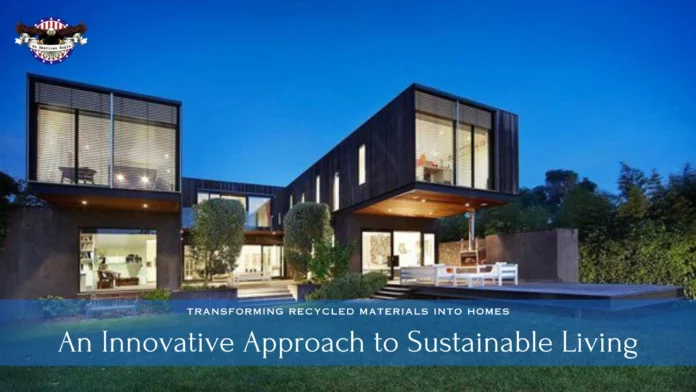Imagine a world where your home is not only a place to rest your head but also a symbol of sustainable living. A world where waste is transformed into something useful and beautiful. Well, that world is not just a figment of your imagination. It’s a reality that is quickly gaining momentum, and it’s all thanks to the innovative approach of transforming recycled materials into homes.
In recent years, there has been a growing interest in sustainable living, and building homes with recycled materials is one of the ways to achieve this. Not only does it reduce waste and landfill usage, but it also provides a cost-effective solution to traditional construction methods.
From shipping containers to reclaimed wood, recycled materials offer a unique and practical alternative to traditional construction methods. Not only do they provide a cost-effective solution, but they also add a touch of creativity and uniqueness to a home.
In this blog post, we’ll dive deep into the world of recycled materials and explore their structural integrity, insulation, and energy efficiency. We’ll also look at how recycled materials can create beautiful and functional living spaces while reducing our impact on the environment.
So, let’s get started on this exciting journey of transforming recycled materials into homes and discover how this innovative approach is beneficial not only for the environment but also for our wallets.
Introduction to Building with Recycled Materials
Building with recycled materials involves the use of materials that have been discarded or repurposed from their original use. These materials include wood, metal, plastics, glass, and even shipping containers.
Using these materials to construct homes not only reduces waste but also helps to conserve natural resources and reduce the carbon footprint associated with traditional construction methods.
Benefits of Building with Recycled Materials
a. Sustainability
Building homes with recycled materials is an excellent way to promote sustainability. By using materials that would otherwise end up in landfills, we are reducing waste and preserving natural resources.
b. Cost-Effectiveness
Recycled materials are often less expensive than new materials, making them a cost-effective solution for building homes. Additionally, recycled materials can be found in abundance, reducing the need for expensive transportation and processing costs.
c. Durability
Contrary to popular belief, recycled materials can be just as durable as new materials. For example, repurposed shipping containers are incredibly strong and durable and can withstand harsh weather conditions.
d. Unique Design Options
Using recycled materials allows for more unique design options, as the materials come in a variety of shapes, sizes, and colors. This means that every home built with recycled materials can be unique and one-of-a-kind.
Examples of Homes Built with Recycled Materials
a. Shipping Container Homes
One of the most popular ways to build homes with recycled materials is through the use of repurposed shipping containers. Shipping container homes are cost-effective, durable, and versatile and can be designed to fit the needs and preferences of the homeowner.
These homes are also incredibly sustainable, as they reduce the need for new building materials and decrease the carbon footprint associated with traditional construction methods.
b. Earthbag Homes
Another innovative way to build homes with recycled materials is through the use of earthbags. Earthbags are essentially large bags filled with materials such as soil, sand, or gravel and are used to build sturdy and affordable homes.
These homes are incredibly energy-efficient, provide natural insulation, and are easy to maintain.
c. Bottle Homes
Bottle homes are another unique way to build homes with recycled materials. These homes use plastic bottles filled with sand, gravel, or dirt, which are then used as building blocks for the walls. These homes are not only affordable and sustainable but are also incredibly beautiful and unique.
Considerations When Building with Recycled Materials
There are several things to consider when building with recycled materials:
a. Building Codes and Permits
Before building a home with recycled materials, it’s essential to check local building codes and permits. Building codes may have specific requirements for the use of recycled materials, and you may need to obtain special permits to build with non-traditional materials.
b. Structural Integrity
When using recycled materials, it’s essential to ensure that they have the necessary structural integrity to support the weight of the home. It’s also crucial to ensure the materials are in good condition and free from defects or damage.
c. Insulation and Energy Efficiency
When building with recycled materials, it’s important to consider insulation and energy efficiency. Recycled materials may not provide the same level of insulation as traditional materials, and additional measures may need to be taken to ensure that the home is energy-efficient.
Conclusion
Building homes with recycled materials is an innovative and sustainable approach to construction that has numerous benefits. From reducing waste and conserving natural resources to providing cost-effective solutions and unique design options, recycled materials offer a practical and environmentally friendly alternative to traditional construction methods.
However, it’s important to consider the structural integrity, insulation, and energy efficiency of the materials used and ensure that local building codes and permits are adhered to.
Building homes with recycled materials is not only a practical solution but also a creative way to transform waste into something useful and beautiful. With the growing interest in sustainable living, this approach to construction is becoming increasingly popular, and we can expect to see more innovative designs and projects in the future.
By using recycled materials to build homes, we can not only reduce waste and conserve natural resources but also create unique and sustainable living spaces that benefit both individuals and the environment.




